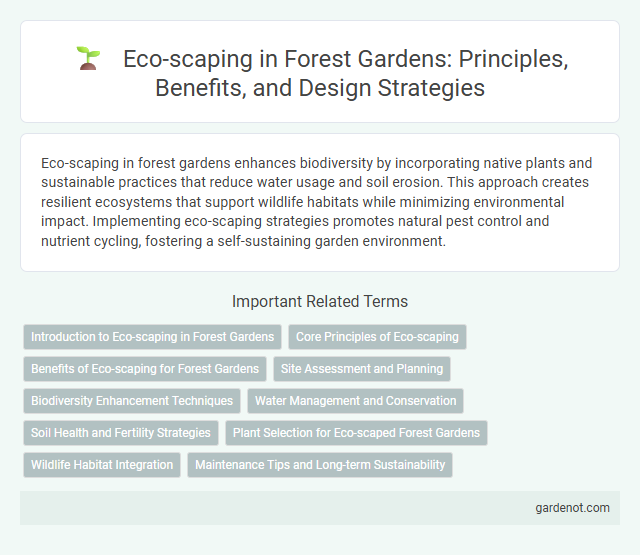Eco-scaping in forest gardens enhances biodiversity by incorporating native plants and sustainable practices that reduce water usage and soil erosion. This approach creates resilient ecosystems that support wildlife habitats while minimizing environmental impact. Implementing eco-scaping strategies promotes natural pest control and nutrient cycling, fostering a self-sustaining garden environment.
Introduction to Eco-scaping in Forest Gardens
Eco-scaping in forest gardens involves designing landscapes that mimic natural ecosystems, promoting biodiversity, and enhancing soil health through native plant selection and sustainable practices. This method integrates permaculture principles to create self-sustaining environments that support wildlife, conserve water, and reduce maintenance. Emphasizing native trees, shrubs, and perennial plants, eco-scaping fosters resilient forest gardens that contribute to ecological balance and long-term sustainability.
Core Principles of Eco-scaping
Eco-scaping in forest gardens emphasizes water conservation, soil health, and native biodiversity by integrating drought-resistant plants and organic mulch to reduce irrigation needs. Utilizing natural pest control methods and promoting habitat for beneficial insects supports ecosystem balance, minimizing chemical use. Designing multi-layered plant structures maximizes sunlight capture and nutrient cycling, enhancing sustainable productivity and resilience.
Benefits of Eco-scaping for Forest Gardens
Eco-scaping enhances forest gardens by promoting biodiversity, improving soil health, and conserving water through native plant selections and natural landscaping techniques. This sustainable approach creates resilient ecosystems that reduce the need for chemical inputs and minimize maintenance efforts. By integrating native species and natural habitats, eco-scaping supports pollinators and wildlife, boosting the overall productivity and ecological balance of forest gardens.
Site Assessment and Planning
Site assessment in eco-scaping for forest gardens involves analyzing soil type, sunlight exposure, water availability, and native vegetation to determine optimal plant placement. Planning integrates permaculture principles to create self-sustaining ecosystems that enhance biodiversity and soil health. Strategic design prioritizes layering of trees, shrubs, and ground covers to maximize space, yield, and ecological balance.
Biodiversity Enhancement Techniques
Eco-scaping in forest gardens employs biodiversity enhancement techniques such as planting native species, creating habitat layers, and integrating pollinator-friendly plants to support diverse wildlife populations. Utilizing companion planting and mulching improves soil health and microhabitats, fostering ecological balance and resilience. These methods contribute to sustainable ecosystem services, including pest control, nutrient cycling, and water retention.
Water Management and Conservation
Eco-scaping in forest gardens emphasizes water management techniques such as rainwater harvesting, swales, and mulching to maximize soil moisture retention and reduce runoff. Implementing drought-tolerant native plants and designing layered plant structures optimizes water use efficiency and supports microclimate regulation. These strategies collectively enhance groundwater recharge, minimize irrigation needs, and promote sustainable ecosystem health.
Soil Health and Fertility Strategies
Eco-scaping in forest gardens emphasizes enhancing soil health through organic mulching, compost application, and integrating nitrogen-fixing plants to boost fertility naturally. Incorporating diverse plant species creates a balanced soil microbiome that promotes nutrient cycling and water retention. Regular soil testing and minimal disturbance techniques further sustain long-term soil structure and nutrient availability.
Plant Selection for Eco-scaped Forest Gardens
Selecting native plant species with high biodiversity value enhances the resilience and sustainability of eco-scaped forest gardens by supporting local wildlife and improving soil health. Incorporating nitrogen-fixing trees and shrubs like alder and black locust enriches the soil naturally while drought-tolerant perennials reduce water consumption. Emphasizing a multi-layered canopy structure with diverse understory plants maximizes space efficiency and ecological benefits in forest garden ecosystems.
Wildlife Habitat Integration
Eco-scaping in forest gardens emphasizes wildlife habitat integration by incorporating native plants and natural features that support local fauna. Creating layered vegetation structures with trees, shrubs, and ground cover provides shelter and food sources for birds, insects, and small mammals. Enhancing biodiversity through habitat corridors promotes ecological balance and sustainability within the garden ecosystem.
Maintenance Tips and Long-term Sustainability
In forest garden eco-scaping, prioritizing native plant species reduces water usage and supports local biodiversity, enhancing long-term sustainability. Regular mulching conserves soil moisture, suppresses weeds, and enriches soil organic matter, minimizing maintenance efforts. Implementing rainwater harvesting systems optimizes irrigation efficiency and fosters resilient plant growth throughout varying seasonal conditions.
Eco-scaping Infographic

 gardenot.com
gardenot.com